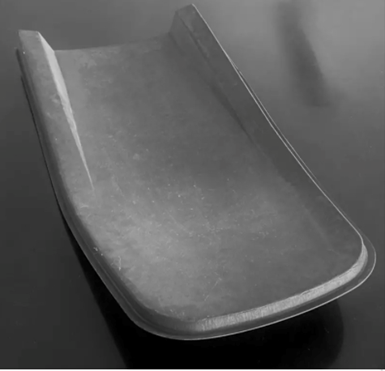Cecence, NCC and Gen 2 Carbon develop sustainable airplane seatback
Conducted life cycle analyses found significant benefits using recycled carbon fiber, with an 84% reduction in carbon emissions.

Photo Credit: Cecence, NCC, Gen 2 Carbon
Design and manufacturing SME Cecence (Salisbury, U.K.), in collaboration with the National Composites Centre (NCC, Bristol, U.K.) and Gen 2 Carbon (Coseley, U.K.), have developed a composite airplane seatback that could reduce CO2 emissions by more than 320 tonnes during the aircraft’s service life, paving the way for more environmentally friendly air travel.
Through the use of sustainable manufacturing methods, Cecence’s fire, smoke and toxicity (FST)-compliant resin system, material engineering and composite seatback design is said to have delivered substantial weight savings in the cabin interior and a further reduction in CO2 per aircraft.
Funded by Innovate UK as part of the Sustainable Innovation Fund, the project aimed to find a sustainable alternative for aero seatbacks, with the NCC being asked to carry out an initial life cycle analysis (LCA) and review Cecence’s already energy-efficient manufacturing processes to see if any further increases in efficiency could be made.
Working with Cecence and Gen 2 Carbon, the team of experts at the NCC used 3D modeling software to simulate composite plies for the new seatback using five different design variations. By conducting and LCA of each design and comparing them to one for the existing seatback currently produced by Cecence, they were able to ascertain which materials and processes were most sustainable, while still meeting aircraft regulations. Significant benefits were found by using recycled carbon fiber instead of virgin carbon fiber, with carbon emissions decreasing from 64 kilograms (~185 pounds) to 11 kilograms (~24 pounds), an 84% reduction in impact.
The dedicated SME team at the NCC also worked with Cecence to analyze their lean manufacturing process and looked at ways of automating a manual bonding process to further increase manufacturing rate. Cecence is now combining this research and applying it to the development of natural fiber composites for the construction and commercial interiors sectors.
“This was a highly successful development project where the team worked well together and delivered extremely positive results,” says Samantha Bunyan, co-founder and head of industry engagement and sustainability at Cecence.
“The work carried out on the SAS [Sustainable Aero Seatback] project has enabled Cecence to accelerate its in-house resin and material development and strengthen its sustainable offerings to aerospace and to a number of other sectors looking for environmentally friendly products,” Bunyan adds. “It was a pleasure to work with the team at the NCC and with Gen 2 Carbon on the nine-month program.”
Related Content
-
Novel dry tape for liquid molded composites
MTorres seeks to enable next-gen aircraft and open new markets for composites with low-cost, high-permeability tapes and versatile, high-speed production lines.
-
The state of recycled carbon fiber
As the need for carbon fiber rises, can recycling fill the gap?
-
Plant tour: Joby Aviation, Marina, Calif., U.S.
As the advanced air mobility market begins to take shape, market leader Joby Aviation works to industrialize composites manufacturing for its first-generation, composites-intensive, all-electric air taxi.
















